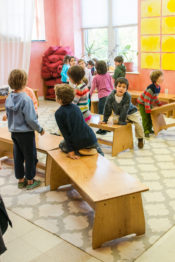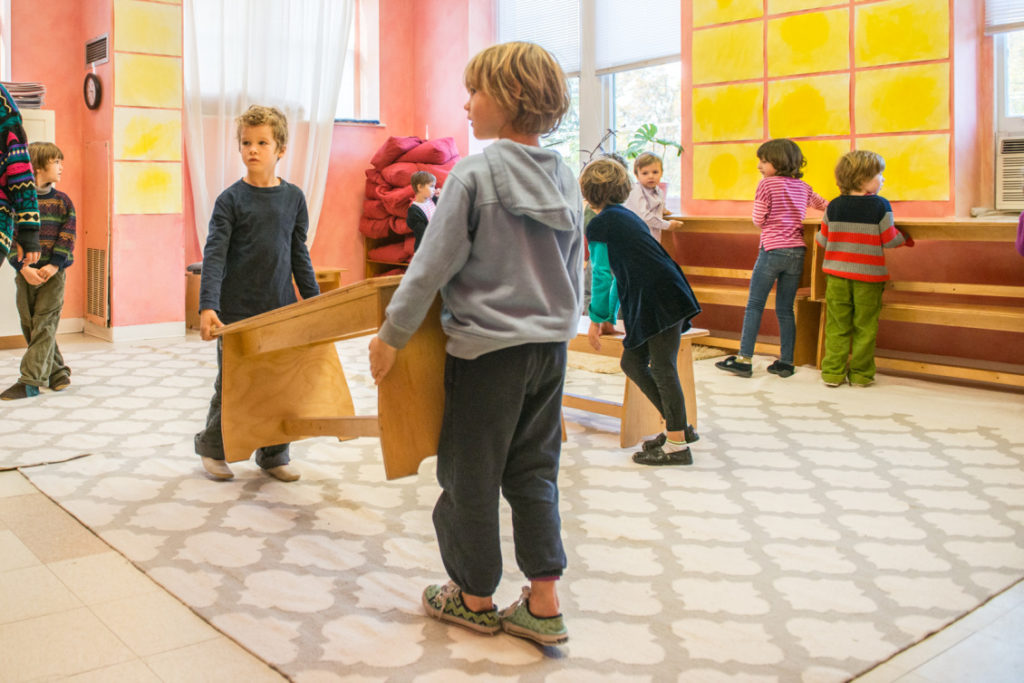Waldorf News
The Moveable Classroom

Picture a first grader. Boundless energy, constantly moving, full of questions and ideas.
Now picture a regular First Grade classroom. Neat First-Grader-sized desks lined up in rows, still and containing.
What happens when you plop the First graders into these strict desks? Energy comes out in fidgets, wiggles, or slouching. They can, at times, have a hard time focusing. They can’t wait for the moment the teacher tells them to push their desks to the back of the room to make space for Circle. What if there were a way to match the composition of the classroom with the development of the child to maximize their learning? Meet the Moveable Classroom.
Thought up some 30 years ago in Scandinavia, the “bewegliche Klassenzimmer”, or moveable/mobile/floating classroom, has taken German Waldorf schools by storm; nearly 1 in 3 have implemented the innovative model. And this year (this article was written in 2014) The Waldorf School of Philadelphia joins the few American Waldorf schools which have adopted the moveable classroom, and it will pioneer this new learning environment.
The greatest strength of the moveable classroom is that it encourages in young students’ qualities that traditional classrooms suppress: movement, expression, and flexibility.
The building blocks of a moveable classroom are comfortable cushions and multipurpose benches, tall and wide enough to be used as tables or benches and light enough to be arranged and rearranged according to the lesson. One of the most exciting features is that the benches become balance beams when flipped over.
The possibilities are endless, especially when you think of the powerful imaginations of the minds that can move them around possess. Check out how some classes have arranged their benches and cushions for all the great learning, playing, moving, soaring, creating, climbing, and munching that takes place in a Waldorf classroom!

As exciting and diverse as the possibilities for the classroom may be, all the fun First graders will be having while moving around will actually help them learn and focus. Since the turn of the century, there has been a flood of research by neuroscientists that explore the link between movement and learning, and the results have been overwhelmingly positive. On a fundamental level, the connection makes sense. Moving around increases blood flow which draws more oxygen into the brain. The more oxygen in the brain, the better it functions.
In his book, Teaching with the Brain in Mind, Eric Jensen highlights some of the scientifically proven benefits that movement offers education. The premise for much of this research is that the cerebellum, the part of the brain that processes movement, has pathways leading to the areas of the brain that process memory, attention, and spatial perception. And the same way that movement grows strong muscles, it has actually been proven to grow the brain!
Neurogenesis, the creation of neurons, has been directly linked to movement by neuroscientist Henriette van Praag in her 1999 study. The brain grows more when the body is moving.
NPR’s More Active Play Equals Better Thinking Skills For Kids concurs that movement is good for brain development. “If you consider the anthropology of humankind, we were designed to move,” Charles Hillman, a professor of kinesiology at the University of Illinois at Urbana-Champaign tells Shots. His study, published September 2014 in Pediatrics, shows 7- to 9-year-old children who run around and play like, well, children, for at least 70 minutes a day show improved thinking skills, particularly in multitasking, compared to children who aren’t as active.
In addition to the wonderful effects of integrating movement more smoothly and consistently in the classroom, the backless benches will encourage better postural control in the children. Studies show that the ability to control posture lessens the amount of energy the brain expends on straining to sit upright and allows for more energy to be spent on executive functions. What are executive functions? According to the National Center for Learning Disabilities, they are the skills used for planning, organizing, strategizing, paying attention to and remembering details, and managing time and space.
This article was written by Sarah Cornelius, a graduate of The Waldorf School of Philadelphia. She is a Truman scholar at Penn and studies political science and education policy.
View this article in it’s original format, with tons of live links throughout the text at phillywaldorf.com.

 Full-Time Teacher Education
Full-Time Teacher Education ~ Ensoul Your World With Color ~
~ Ensoul Your World With Color ~ Train to Teach in Seattle
Train to Teach in Seattle Resiliency and the Art of Education
Resiliency and the Art of Education Middle School Science With Roberto Trostli
Middle School Science With Roberto Trostli Great books for Waldorf Teachers & Families
Great books for Waldorf Teachers & Families Transforming Voices Worldwide
Transforming Voices Worldwide Bringing Love to Learning for a Lifetime
Bringing Love to Learning for a Lifetime Flexible preparation for your new grade
Flexible preparation for your new grade Waldorf-inspired Homeschool Curriculum
Waldorf-inspired Homeschool Curriculum Association for a Healing Education
Association for a Healing Education Everything a Teacher Needs
Everything a Teacher Needs Bay Area Teacher Training
Bay Area Teacher Training Apply Today: New Cohort Starts Nov. 2025
Apply Today: New Cohort Starts Nov. 2025 Jamie York Books, Resources, Workshops
Jamie York Books, Resources, Workshops The Journey is Everything
The Journey is Everything Immersive Academics and Arts
Immersive Academics and Arts Waldorf Training in Australia
Waldorf Training in Australia
 Space speaks. Its language is movement.
Space speaks. Its language is movement. Roadmap to Literacy Books & Courses
Roadmap to Literacy Books & Courses Waldorf EC Training & Intensives in Canada
Waldorf EC Training & Intensives in Canada Caring for All Stages of Life
Caring for All Stages of Life Summer Programs - Culminating Class Trips
Summer Programs - Culminating Class Trips Quality Education in the Heartland
Quality Education in the Heartland RSS Feeds
RSS Feeds